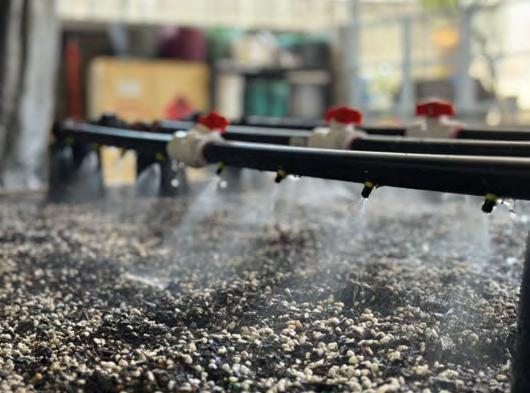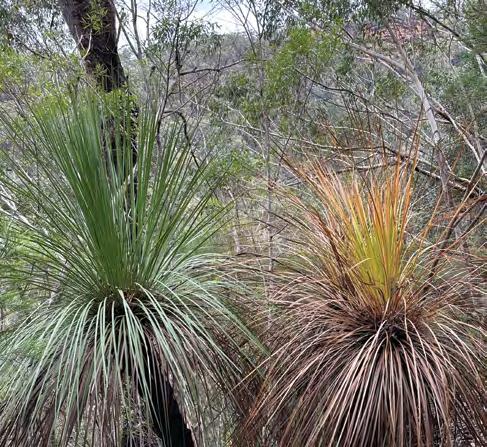
6 minute read
Protecting our native plants
Professor Brett Summerell AM, Chief Scientist and Director Science, Education and Conservation, talks about the importance of protecting our native plants from Phytophthora root rot, and the preventative steps the Botanic Gardens is taking.
One of the major threats to the survival of Australian plants, is the impact of root disease caused by Phytophthora species. These plant pathogens, which are not fungi but Oomycetes, include one species, Phytophthora cinnamomi, which is listed as a key threatening process in both Federal and New South Wales legislation.
As soilborne micro-organisms attack root systems of susceptible plants they are impossible to observe, difficult to detect and diagnose, and by the time symptoms can be seen in affected plants it is often too late. The number of plant species affected by Phytophthora is enormous, spanning species in the natural environment, exotic species in our gardens and parks and a range of agricultural and horticultural crop species. This disease is listed as a threatening process for many threatened species including the iconic Wollemi Pine.

Working towards a solution
At the PlantClinic the most common request we get is to determine the presence of Phytophthora in soil samples or on the roots of trees and shrubs with dieback symptoms. Traditionally this process was time consuming, involving baiting soil with plant parts such as lupins, the seedling leaves of Eucalyptus or apple or pear fruit for 5-7 days. The soil needed to be flooded to enhance sporulation and growth of the pathogen, placed on agar media to grow out the pathogen, which was then transferred to another plate of media, grown and identified down the microscope. All of this took a month or more and was dependent on very specific expertise – which was unfortunately inefficient and not very sensitive.
Over the years we have enhanced this process replacing the plant baits with consistent, easily produced agar-based baits and microscope identification replaced with DNA based identification tools that are highly sensitive and allow us to definitively differentiate different species of Phytophthora. This latter factor is critical as there are hundreds of species globally with over 90 recorded in Australia – of these some are very aggressive pathogens; some are specific to different plant species, and some are even native and apparently benign. It is also critical that we are monitoring for any new incursions of further exotic species, and one species in particular, Phytophthora ramorum – the sudden oak death pathogen currently devastating forests on the west coast of the USA – is a major biosecurity concern for Australia.


These enhancements have improved our capacity to detect Phytophthora, but it was still a time-consuming, laborious process to extract the pathogens from soil. We have been working with our partner, Ecopath Solutions, to develop a scalable extraction process that allows us to process tube stock, potted plants, soil and water samples, and bulk batches of potting mix constituents. The system works in a sealed chamber made from an intermediate bulk container (IBC – a 1000 litre container supported by an aluminium or steel frame) with a computer-controlled irrigation system built into the top of the IBC.
The computer controls are programmed to mimic the irrigation conditions which maximise the production and release of the motile zoospores (small swimming spores that initiate infection of the plant) of the pathogen. These zoospores are captured in the leachate flowing out of the IBCs and are concentrated in a trap where nutrient-rich agar baits attract the zoospores. In the laboratory the agar baits are added to a solution of nutrients and incubated for several days to enrich the amount of biomass of the pathogen.
Once this happens, we can either directly extract the DNA and determine the presence and species make up or use a lateral flow test that is specific for the most important species of Phytophthora. This is similar to a COVID-19 test and takes the same amount of time to give a result which is a huge time saver. All of this means we are now able to cut the diagnostic time down from weeks to 5-7 days, improve the sensitivity of detection by factors of 10 and accurately differentiate species of Phytophthora with precision. The system also allows us to batch-test multiple plants at one time, dramatically reducing costs.
Looking to the future
Currently we are looking to implement a testing station at each of the Botanic Gardens for all plants that come into the gardens, to ensure the potential for any pathogens to be introduced into our estates is eliminated. A focus area has been to carefully test threatened plant populations we are growing up to reintroduce back into the wild or to be used in translocations to avoid introducing a pathogen into such sensitive and important plantings. We have also done some regular testing of Growing Friends Plant Sales stock with excellent results and no positive detections – another good reason why you should get your plants there!
Our future plans are to roll this system out to the nursery and restoration industries. Our previous research has shown that the proportion of plants produced for urban greening projects that have Phytophthora can be as high as 30 per cent.
It is possible to reduce this through careful attention to hygiene practices and manage all stages of the propagation process – clean irrigation water, clean potting mixes, growing off the ground – but this can only be facilitated by a rapid, cost-effective testing scheme. We believe we have now developed such a system and are looking to deploy it in partnership with nurseries to enhance the production of clean healthy plants that have a head start on life.
Diseases like Phytophthora not only have a detrimental effect on the health of plants affected by them but also on all the forms of life that in turn depend on those plants, on the communities of people that need resilient green spaces to moderate urban heat effects and ultimately on all of us who need a green and healthy environment in which to co-exist.










